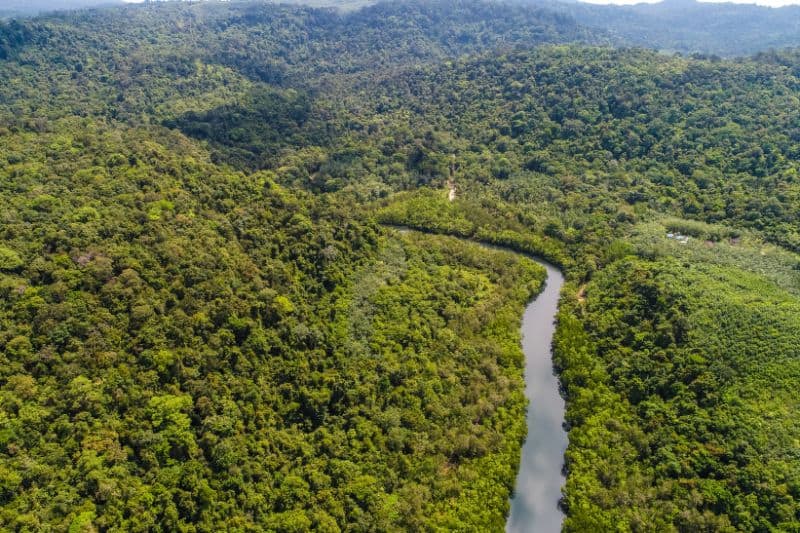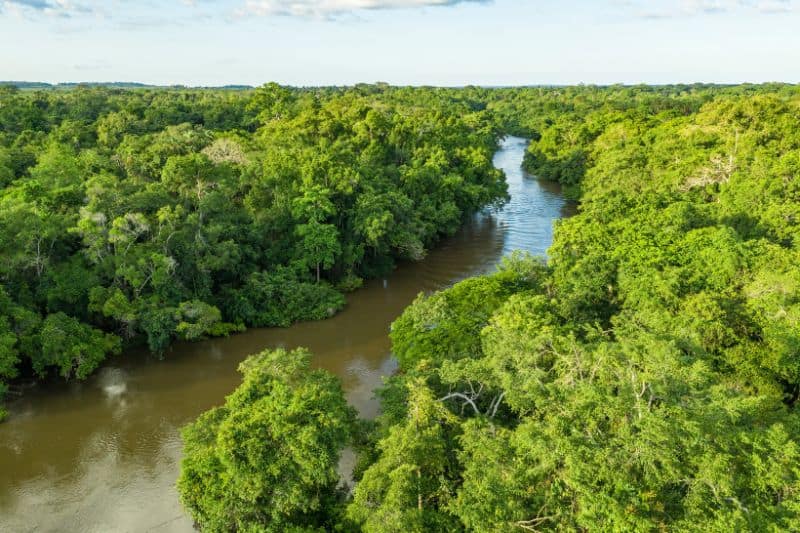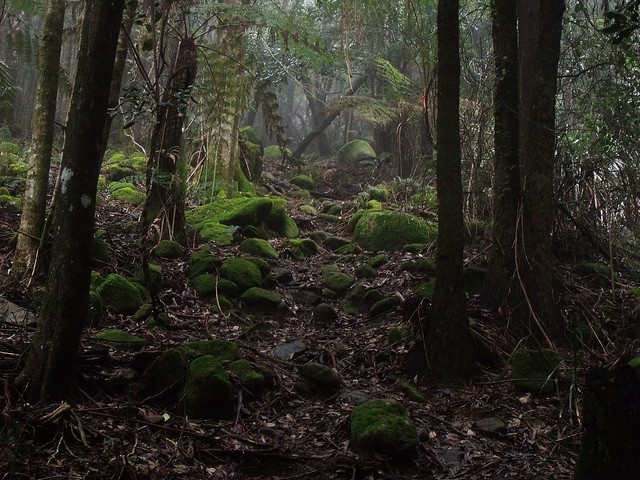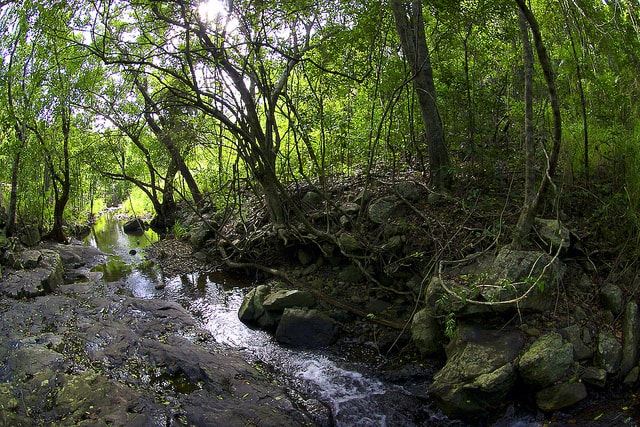Millions of years ago, before humans, before the ice ages, and when planet Earth was warm and humid, forests covered much of the earth. It was in these forests that an abundance of life evolved. The remnants of these prime dense jungles make up the rainforests of today.
The Amazon Basin is the largest rainforest, covering about 5.5 million square kilometers across nine countries. The majority of the Amazon rainforest occurs in Brazil(60%), followed by Peru(13%), Colombia (10%), and smaller patches in other countries such as Ecuador, Venezuela, Bolivia, Guyana, and Suriname, just to name a few.
It is watered by the world’s mightiest river (Amazon River) and home to the greatest diversity of living things anywhere. Dozens of these living species are still discovered each year. Scientists believe the Amazon rainforest has existed for the last five million years.
Rainforests are tall, hot, and dense forests found all around the world and serve a significant purpose in the environment. They serve as the Earth’s oldest ecological system.
Although the rainforest biome covers only around 6% of the earth, amazingly, they account for ½ of the plants and animals found on the planet! In a nutshell, a rainforest is a dense jungle.
As the name suggests, rainforests are forests that receive more than 1000 mm of rainfall throughout the year and are mostly found around the middle of the earth near the equator, like South and Central America, Africa, Asia, and Australia.
Features of Rainforests
A rainforest is a large area characterized by tall and thick jungles. For a forest to be called a rainforest, it must have the following features:
1. A High Amount of Rainfall
Rainforests are typically situated in areas of wet tropical climates and receive an average rainfall ranging between 80 inches and 430 inches each year.
The high rainfall is majorly contributed by the process of transpiration, leading to increased humidity and cloud formation. Due to increased transpiration, rain falls almost every day.

2. Rich Biodiversity
Rainforests have the largest biodiversity of any habitat on the globe. In fact, this biome contains far more plant and animal species per square mile than any other forest habitat.
3. Warm Temperature and Low Latitude
Most rainforests experience warm climates throughout the years except those at higher levels. Average temperatures in rainforests are between 72 and 93 degrees Fahrenheit, with little fluctuations.
And since they are located within the tropics, most rainforests occur near the equator, particularly in locations with latitudes below 23 degrees North and South.
4. Have a 4-layer Canopy Structure
Rainforests are characterized by a unique 4-layer canopy structure. This includes the emergent layer, which is the highest layer with 130-foot tall trees; the canopy layer, which is the primary layer of the forest and features trees with heights between 100 and 130 feet; and the understory, where plants seldom grow.
The understory is mainly made up of trees and shrubs with heights between 20 to 60 feet above the forest floor. Lastly, we have the forest floor, which is relatively dark, permitting no plants to grow.
The Four Layers of the Rainforest
As just said, a typical rainforest contains a total of four layers.
The Emergent layer is one of those layers. This layer holds the tallest trees and plenty of beautiful sunlight. Trees in the emergent layer can grow to 200 feet, with trunks measuring up to 16 feet in width.
The Canopy layer is the primary rainforest layer. This layer protects the other layers and offers beautiful oval and smooth pointed leaves. There are many animals living in the Canopy layer, such as tree frogs, snakes, and more.
The Understory layer is also a rainforest layer. This area has very little sunshine, and plants usually have larger leaves. You will find many animals in this area, including leopards and jaguars.
The final layer is the forest floor layer. This area of the rainforest is dark and contains very few plants. Decay is common in this level of the rainforest. Anteaters live on the Forest Floor.
The name rainforest exists because these areas are susceptible to heavy rainfalls throughout the year. It is estimated that around 30 million plants and animals reside in the rainforest.
Although you may not put a lot of thought and consideration into the rainforest, perhaps you should. We depend on the rainforest for many of the things that are found inside our homes.
In fact, even some of the foods that we consume are made possible through the rainforest. Medicine, pineapples, and chocolate are among the things that come from the rainforest.

Why are Rainforests Important?
The rainforest is important for numerous reasons. Located between the equator 23.5 degrees north and south, rainforests have two seasons: rainy season and dry season.
They also contain millions of species of exotic plants and animals. From medicine to chocolate to paper, we depend on the rainforest.
So, as you may suspect, this is the first benefit found with the rainforest. Inside the rainforest are many plants and animals that supply us with so many things, as listed below.
- Natural medicines
- Oxygen production
- Sugar Spices such as coconut, vanilla, turmeric, ginger, etc.
- Rubber
- Bamboo
- Pineapples
- Chocolates that come from cocoa, which grows on trees in rainforests
Apart from this, they also:
- Stabilize the world’s climate.
- Make an exciting place to visit.
- Maintain water cycle.
- Provide a home to tribal people.
- House more than 1/2 of the world’s plant and animal species.
- Protect the environment against soil erosion, floods, and droughts.
Another benefit found from the rainforest is regulating global and regional climate systems, serving as an all-natural heat and water pump.
Heat is released into the atmosphere, which results in rain. You will also appreciate that the rainforest helps control carbon dioxide levels in the air. This minimizes global warming and helps control emissions.
Would you be surprised to learn that around 70% of all anti-cancer plants used today are found in the rainforest?
This is just one of the many medicinal contributions made by the rainforest.
Let’s embark on the benefits now:
1. A Great Food Source
Statistically, 80% of the world’s diet originates from rainforest plants. Most fruits exported worldwide come from the Amazon rainforest, for example, bananas, coffee beans, nuts, and pineapples, to name a few.
This explains why rainforests should be conserved at all costs. Deforestation is the primary source of rainforest degradation in the world. If we allow the trend to go on unabated, we could lose a significant percentage of our food supply.
2. Production of Oxygen
Rainforests contribute to about 20% of the world’s oxygen, which is why they are called “the lungs of the world.” The forests and accompanying soils suck up and lock away carbon.
This is a critical function considering this day and age where humans contribute to so much carbon emission via transportation and fossil fuel power plants. According to scientific studies, forests suck up approximately 20% of the globe’s human-triggered carbon emissions.
3. Largest Source of Medicine
Modern medicines utilize hundreds of rainforest plants found around the globe. In fact, according to veritable research, 25% of modern-day medicines originate from rainforest plants.
For instance, the cocoa tree found in tropical rainforests produces over 155 chemicals. These chemicals are extracted from its leaves, bark, seeds, and fruits. The extracts treat kidney stones, coughs, fever, anxiety and bruises.
Another example is the Vincristine, which is extracted from the rosy periwinkle of Madagascar. Vincristine has enabled up to an 80% of remission rate for some kinds of childhood leukemia.
An interesting fact is that only 1% of the plant species in rainforests across the world have been studied. This means there is a huge potential to discover even more powerful medicines in this natural habitat.
4. Rich Biodiversity
Half of the plant and animal species living on earth are found in rainforests. Rainforests harbor a third of the globe’s bird species and 90% of its invertebrates. This rich biodiversity offers humans an opportunity to enjoy the world’s natural wonders through tourism and exploration.
5. Regulates the World’s Water Cycle
Rainforests are vital to regulating the water cycle throughout the world. They are the major sources of rivers, lakes, and oceans. Trees play a crucial role in the water cycle by sucking up and store water in their roots and release it into the atmosphere.
In the Amazon, for instance, over half of the water in the ecosystem is held within the greenery (plants). Without the greenery, the climate could become drier and growing food could turn out to be impossible to many.
6. Mitigate Climate Change
Lack of trees can lead to the climate change phenomenon. Deforestation wipes out a good portion of the forest canopy, which blocks sun rays during the day and holds in heat during the night. These disruptions result in temperature swings in rainforests that can affect growth of plants and flourishing of animals.
Trees are also critical in sucking up greenhouse gasses that trigger global warming. Fewer rainforests mean a lot of greenhouse gasses making it to the atmosphere, leading to increase in the severity of global warming.
Where are Rainforests Located?
Rainforests are mainly divided into two categories: tropical and temperate.
Tropical rainforests naturally occur close to the equator, with 57% of all tropical rainforests in the world occurring in Latin America.
Brazil leads with one-third of the entire world’s tropical rainforests. Southeast Asia and Pacific Islands contain 25% of the world’s tropical rainforests, with West Africa boasting 18%.
Temperate rainforests, on the other hand, are situated along certain coasts in temperate zones. The world’s largest temperate rainforests are situated on the Pacific coast of North America. They cover a stretch of 1,200 miles, which is from Oregon to Alaska.
Some patches of temperate rainforests occur in South America, on the South Coast of Chile, to be specific. Some small parts of the U.K., Southern Australia, New Zealand, Norway, and Japan have temperate rainforests.
Famous Rainforests in the World
Now that we’ve looked at features of rainforests, their benefits, and where they’re located, lets explore some of the world’s notable rainforests:
1. Amazon Rainforest
Commonly known as Amazonia by the locals. It’s the largest rainforest on the globe spread over an estimated area of 1.7 billion acres of land across different countries.
Brazil takes the biggest chunk of the Amazon rainforest (60%). Amazon rainforest also runs through countries like Peru, Colombia, Venezuela, Ecuador, Bolivia and so on.
2. Daintree Rainforest
Daintree is a tropical rainforest named after Richard Daintree, a pioneer Australian geologist and photographer. It is situated on the north-east coast of Queensland, in the larger Australia.
It takes up an estimated area of 2,600 square kilometers. Daintree rainforest consists of some of the ancient plants on planet earth like the Lycopsida and Psilotopsida, which makes it one of the most significant rainforests in the world.
3. Alaska’s Rainforests
The Alaska’s rainforests are located in the United States. They consist of the Tongass rainforest in Southeast Alaska, which is the biggest, followed by the Chugach rainforest in South-central Alaska and lastly, the Boreal forest, which occurs in the interior.
These three rainforests harbor a vast array of unique plant and animal species such as hemlock, stands of spruce, mosses, cedar trees, wildflowers including wide varieties of berries. They are frequented by nature lovers.

4. The Congo Rainforest
Situated in Central Africa, the Congo rainforest is considered the second largest rainforest on the globe after Amazon.
It contains long rivers snaking through it. The rainforest takes up a significant chunk of Northern Congo. Hunting activities have put animal species here in grave danger.
Overall, the rainforest is a safe for human exploration. The unique species in this rainforest is the pygmy chimpanzee, living amidst other precious animal and plant species.
5. Southeast Asian Rainforest
Southeast Asian Rainforest is the oldest and consistent in the world. It has an unrivaled biological richness and diversity. This rainforest was once extremely dense, but massive deforestation has wiped out most of the vegetation. Southeast Asian rainforest harbors some of the rarest mammal, reptile, amphibian and bird species.
Why are Rainforests Disappearing?
Scientific evidence suggests that, unless we make changes right away, rainforests will no longer be a part of our world in another 100 years or so.
But why are rainforests slowly growing thin?
There are a number of causes of rainforests disappearing from the world. One of those is because trees are being destroyed for the logging industry.
Introducing non-native plants and animals into the rainforest is also another cause of rainforest depletion. Tourism and other needs for land is yet another cause of rainforests and their endangered status.
Man made activities are another drive for rainforest destruction. We need roads, pulp for making paper, land for agriculture, wood for timber, extraction of minerals and energy and many more. All these activities require eradication of forest land i.e. deforestation.
Climate change is another problem that is contributing to droughts in many parts of Amazon and Southeast Asia. Drought increase the risk of forest fires. The smoke can cause widespread health problems and increases concatenation of carbon dioxide in the atmosphere.
What Can You Do?
Maintaining our beautiful rainforests is in everyone’s hands. You can easily make a great contribution and ensure they are here for your children, their children and their children to enjoy. Here are a few ways to save the rainforests!
- Donate Money to Research Causes and Organizations: Even a small $20 contribution can mean a great deal to these organizations who are working to maintain the rainforest. You will feel good knowing that you did your part, too!
- Reduce, Reuse & Recycle: The three R’s of life…make sure that you follow them. Reduce your waste, reuse what you can and recycle all of your plastic, paper and cardboard, as well as glass, aluminum and similar items.
- Shop only with companies that are environmentally friendly.
- Join in on the fun at rallies, forums, etc. Your voice is very powerful and can make a difference!
Saving the rainforests is something that we all must work together to do. Ensure that you are in on the action.







